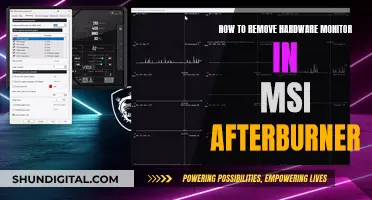
The volume level of studio monitors is a crucial aspect of music production, impacting the accuracy of the mix and the health of the producer's hearing. While there is no one-size-fits-all answer, several guidelines and best practices can help achieve optimal results. Firstly, it is recommended to keep the volume between 75 dB and 85 dB, as this range provides a flat response across low, mid, and high frequencies, allowing for better balance in the mix. However, this range may vary depending on factors such as room acoustics and speaker quality.
To ensure consistent results, it is essential to calibrate the studio and listening environment, taking into account factors such as voltage and sound pressure levels. While the specific volume knob position may differ for each setup, it is generally advised to keep the volume at a level that allows for comfortable conversation without raising your voice. This approach ensures that the producer can accurately judge the volume of all frequencies and prevents hearing fatigue, which can occur at relatively low volumes over extended periods.
Additionally, it is worth noting that different genres may require different volume levels due to variations in mid-frequency volumes. It is recommended to adjust the volume accordingly and be mindful of potential hearing damage from prolonged exposure to sound pressure levels above 85 dB.
| Characteristics | Values |
|---|---|
| Ideal volume level | 85 dB |
| Volume level to avoid hearing loss | Below 85 dB |
| Volume level for conversation level | Slightly above conversation level loudness |
| Volume level to avoid noise | Avoid turning the interface volume very low and the speakers all the way up |
| Volume level to avoid clipping | Avoid turning the interface volume very high and the speakers very low |
What You'll Learn

The ideal volume level for studio monitors
Decibel Recommendations
One common recommendation is to set your studio monitors to around 85 dB (decibels). This falls within the range of 75-85 dB, which is often cited as the ideal range for mixing and music production. At this level, the perceived loudness is very flat, allowing for an accurate judgement of the balance between low, mid, and high frequencies. It is important to note that sound pressure levels above 85 dB can cause permanent hearing loss if exposed for 8 hours or more, so it is crucial to be mindful of both volume and duration when working with studio monitors.
Subjective Approach
While the 85 dB guideline is widely accepted, some professionals suggest a more subjective approach, as the ideal volume can vary depending on individual hearing ability and the style of music being produced. Different genres require different volume levels, as mid-frequency levels vary across genres. For example, a bass-heavy Dub track will require a different volume setting than a Radio Pop song with upfront lead vocals or bright lead synths. The Pop song, in this case, will sound louder.
Mixing and Production Considerations
When it comes to mixing and music production, a rule of thumb is to keep the volume at a level where you don't need to raise your voice to talk to someone. An acoustically treated room can allow for even lower volumes, with an average of 70 dB being comfortable. It is important to take breaks during long sessions to prevent hearing fatigue and protect your ears. Additionally, lower volumes can reduce the impact of room acoustics, resulting in fewer problems with standing waves, reverb, and unwanted vibrations.
Gain Staging and Noise Control
Proper gain staging is crucial for optimal signal-to-noise performance. It is generally recommended to maximise the volume on the source device, such as the audio interface or computer, and use the volume controls on the studio monitors for adjustments. This ensures that the last device in the chain has the final say in the volume level, providing the widest range of volume control. However, it is important to find a balance, as cranking the volume too high can introduce noise and distortion.
Monitor Placement and Calibration
The distance between the monitors and the listener plays a significant role in the perceived volume. Near-field monitors placed closer to the listener can provide adequate volume at lower settings compared to monitors placed further away. It is essential to consider the size of the room and the placement of the monitors to find the optimal volume level. Calibration tools and techniques can also help ensure that your studio monitors are accurately reproducing the desired volume levels.
In conclusion, while there is no one-size-fits-all answer to the ideal volume level for studio monitors, following the guidelines and best practices outlined above can help you find the optimal setting for your specific needs. Protecting your hearing, understanding the impact of volume on sound perception, and calibrating your equipment are key aspects of setting the right volume level for your studio monitors.
Connecting Your Desktop to an HDMI Monitor: A Step-by-Step Guide
You may want to see also

The volume level of the studio monitor and the audio interface
The volume level of your studio monitors and audio interface is a critical aspect of achieving the desired sound quality and protecting your hearing health. Here are some insights and recommendations to consider:
Recommended Volume Levels:
- The ideal volume level for studio monitors is often suggested to be around 85 dB. This falls within the range of 75-85 dB, which is considered the sweet spot for mixing, as it allows for better judgment of the balance between low, mid, and high frequencies.
- However, some find 85 dB too loud and prefer mixing at lower volumes, such as 70-80 dB. This is especially true for those with smaller rooms or untreated acoustic spaces.
- Ultimately, the volume level depends on your personal preference, the genre of music, and the quality of your speakers.
Health and Safety Considerations:
- Prolonged exposure to sound pressure levels above 85 dB can lead to permanent hearing loss. It is crucial to be mindful of this and avoid excessive volumes, especially over extended periods.
- A good rule of thumb is to keep the volume at a level where you can comfortably converse without raising your voice.
- It is recommended to take breaks during extended mixing sessions to give your ears a rest and prevent hearing fatigue.
Technical Tips:
- It is generally advised to keep the volume knobs on your studio monitors at a moderate level and use the audio interface or a monitor controller to adjust the volume. This helps maintain optimal signal-to-noise performance and provides more flexibility in volume control.
- Avoid maxing out your monitors to prevent potential damage from unexpected loud noises or "pops."
- Calibrating your studio monitors and ensuring proper gain staging can help optimize sound quality and prevent distortion.
- Using a decibel meter to measure and match the volume of each speaker can ensure an accurate and balanced listening experience.
Connecting Apple TV to a Monitor: A Simple Guide
You may want to see also

The volume level of the studio monitor and the room size
The volume level of studio monitors depends on factors such as room size, the style of music, and the condition of one's hearing. The generally recommended volume level for studio monitors is between 75 and 85 dB, as this range is considered to be the most flat in terms of perceived loudness, allowing for the best balance between low, mid, and high frequencies. However, it is important to note that sound pressure levels above 85 dB can cause permanent hearing loss if one is exposed for 8 hours or more. Therefore, it is recommended to keep the volume at a level where one can comfortably talk to someone without having to raise their voice.
The volume level of studio monitors can also depend on the size of the room. For smaller rooms, it is recommended to keep the volume lower to avoid excessive sound pressure and standing waves that can cause problems with the room's acoustics. In a well-treated room, the volume can be turned down to an average of 70 dB without sacrificing sound quality. On the other hand, for larger rooms, a higher volume level may be necessary to ensure that the sound fills the space adequately.
It is also worth considering the style of music when setting the volume level of studio monitors. Some genres, such as bass-heavy Dub or bright Pop, may require slightly different volume levels to achieve the desired sound. Additionally, as one ages, their hearing may change, and the volume level may need to be adjusted accordingly.
When setting up studio monitors, it is important to calibrate the system to ensure optimal sound quality. This involves setting the monitors to a reference level, typically around 85 dB, and then adjusting the volume based on the specific needs and preferences of the user. It is recommended to mark the position of the monitor volume knob so that the calibration can be easily returned to in the future.
In conclusion, the volume level of studio monitors depends on a combination of factors, including room size, music style, and hearing ability. It is important to find a balance between achieving the desired sound and maintaining safe listening levels to protect one's hearing. Regular breaks during long mixing sessions are also recommended to prevent listening fatigue and potential hearing damage.
Connecting X10 Cameras: Monitor Setup Guide
You may want to see also

The volume level of the studio monitor and the genre of music
The volume level of your studio monitors will depend on several factors, including the genre of music you are producing, the size of your studio space, and your own personal preference.
According to the Equal Loudness-contour, a volume level between 75dB and 85dB is recommended as the perceived loudness is very flat in this area, allowing you to judge the balance between low, mid, and high frequencies. At these levels, you can also identify any issues with your mix, as it is loud enough to hear any problems without being so loud that it causes hearing damage.
Some genres of music may require a higher volume than others. For example, a bass-heavy Dub track will require a different volume level than a Radio Pop song with lead vocals or bright lead synths. The Pop song will typically sound louder due to the higher mid-frequencies.
The size of your studio space will also impact the ideal volume level for your monitors. A larger space will require a higher volume level than a smaller space to achieve the same perceived loudness. Most home studios are smaller than 142 cubic meters, so a volume level between 73dB and 76dB SPL C is generally recommended.
Finally, personal preference will also play a role in determining the ideal volume level for your studio monitors. Some people prefer to mix at lower volumes to reduce ear fatigue, while others may prefer a higher volume level to feel the full impact of the music. Ultimately, you should find a volume level that works best for you and your specific studio setup.
Bar's Ankle Monitor: Surveillance or Punishment?
You may want to see also

The volume level of the studio monitor and the health of your ears
The volume level of your studio monitor can impact the quality of your mixes and the health of your ears. While there is no one-size-fits-all answer, here are some guidelines and tips to help you find the optimal volume for your studio monitor while protecting your hearing:
- Decibel (dB) Recommendations: According to the Equal Loudness Contour, a volume level between 75dB and 85dB is recommended as it provides a flat response across low, mid, and high frequencies, allowing you to better judge the balance between them. However, some genres may require higher volumes due to differences in mid-frequency levels. Keep in mind that prolonged exposure to sound pressure levels above 85dB can lead to permanent hearing loss.
- Subjective Approach: The optimal volume also depends on your hearing ability and the style of music you produce. It is essential to know where the volume knob should be to achieve your personal "music production volume." This can be determined by using a sound pressure level (SPL) meter app on your phone to measure the volume around your ear position.
- Rule of Thumb: A general guideline is to keep the volume at a level where you don't need to raise your voice to talk to someone. An acoustically treated room can allow you to work with lower volumes, typically around 70dB on average.
- Listening Fatigue: Our hearing can handle high volumes for a short period of time. Prolonged exposure to extremely high sound pressure levels can lead to hearing fatigue, temporary or permanent hearing loss, and ringing in the ears. It is important to take breaks during long production sessions to reset your ears and prevent fatigue.
- Gain Staging: It is recommended to use the volume control on your studio monitors sparingly and adjust the volume using the last device in your audio chain, such as your audio interface or a dedicated monitor controller. This helps maintain optimal signal-to-noise performance and ensures that any volume adjustments are made consistently across all speakers.
- Experimentation: It is crucial to understand the loudness at each step of your volume control. Experiment with different volume levels to find the optimal setting for your specific setup and genre. Remember that louder sounds can be perceived as better by our brains, so it is essential to mix at various volumes to ensure your mix translates well.
- Reference Volume: Establish a reference volume level for your studio by calibrating your equipment and listening environment. This ensures that your gear is operating at optimal voltage levels and helps you make consistent mixing decisions. Return to this reference level when making critical decisions about your tracking or mixing.
Monitoring Bandwidth Usage in Linux: A Comprehensive Guide
You may want to see also
Frequently asked questions
The ideal volume for studio monitors is considered to be around 85 dB. However, this may vary depending on factors such as room size, personal preference, and the style of music being produced.
The volume of studio monitors can be controlled by adjusting the knobs on the monitors themselves or by using the volume controls on the audio interface or computer. It is generally recommended to keep the monitors at a moderate level and adjust the volume using the interface or computer.
Yes, the recommended decibel value for music production is between 75 dB and 85 dB. This range provides a flat perceived loudness, allowing for better judgment of the balance between low, mid, and high frequencies.
Prolonged exposure to sound pressure levels above 85 dB can cause permanent hearing loss. It is important to be mindful of the volume levels and take breaks to protect your hearing.
Higher volumes can excite the walls and objects in the room, causing problems such as standing waves, increased reverb, and unwanted vibrations. Lower volumes can help reduce these issues and provide a clearer sound for mixing.







